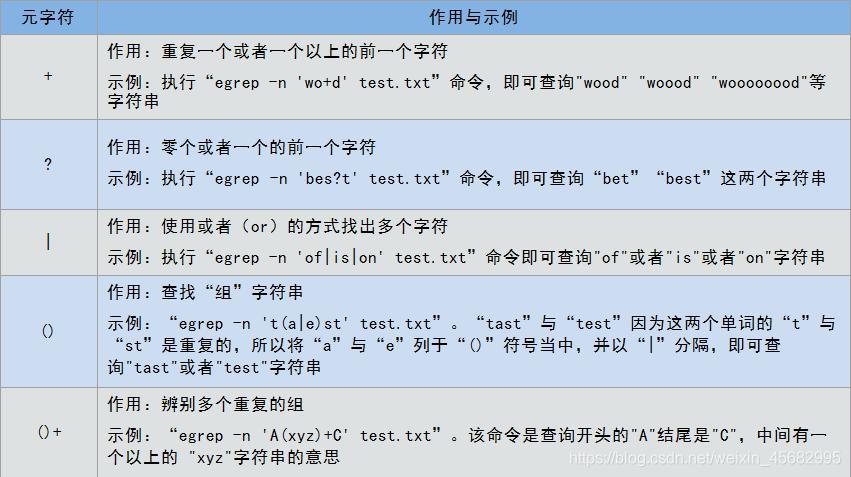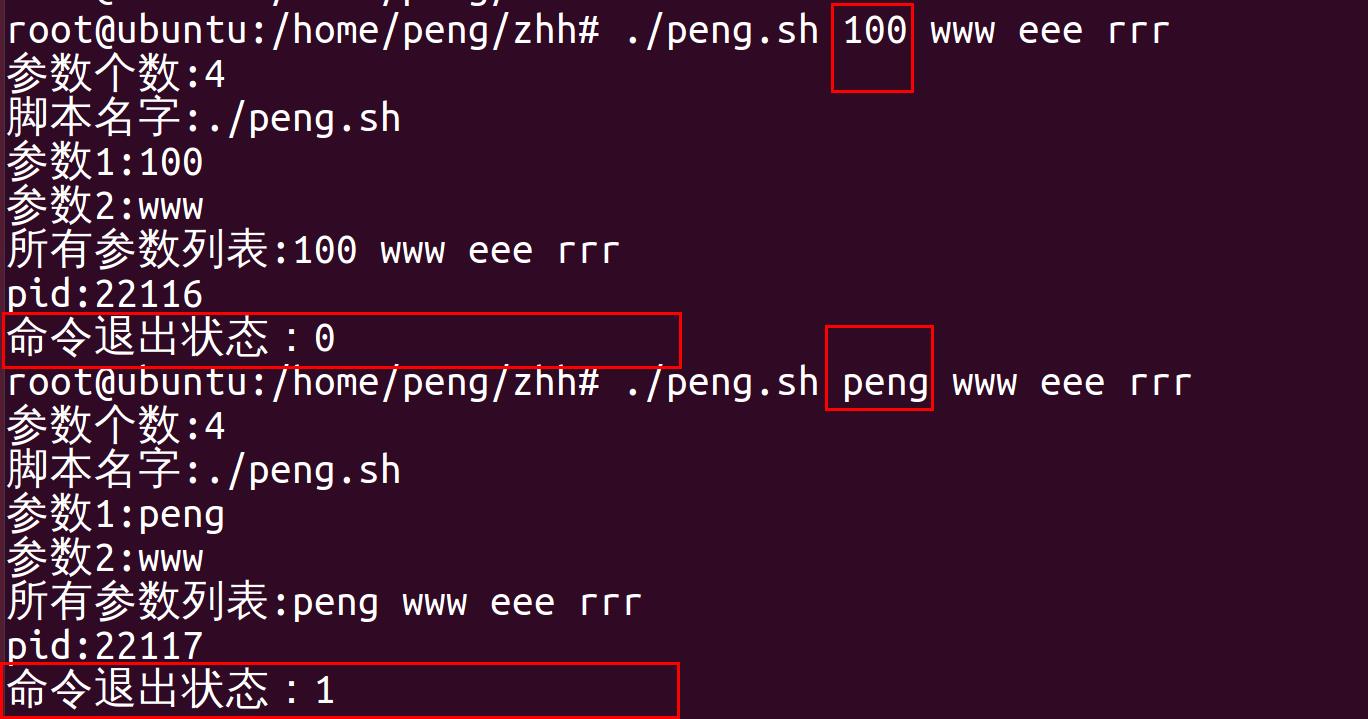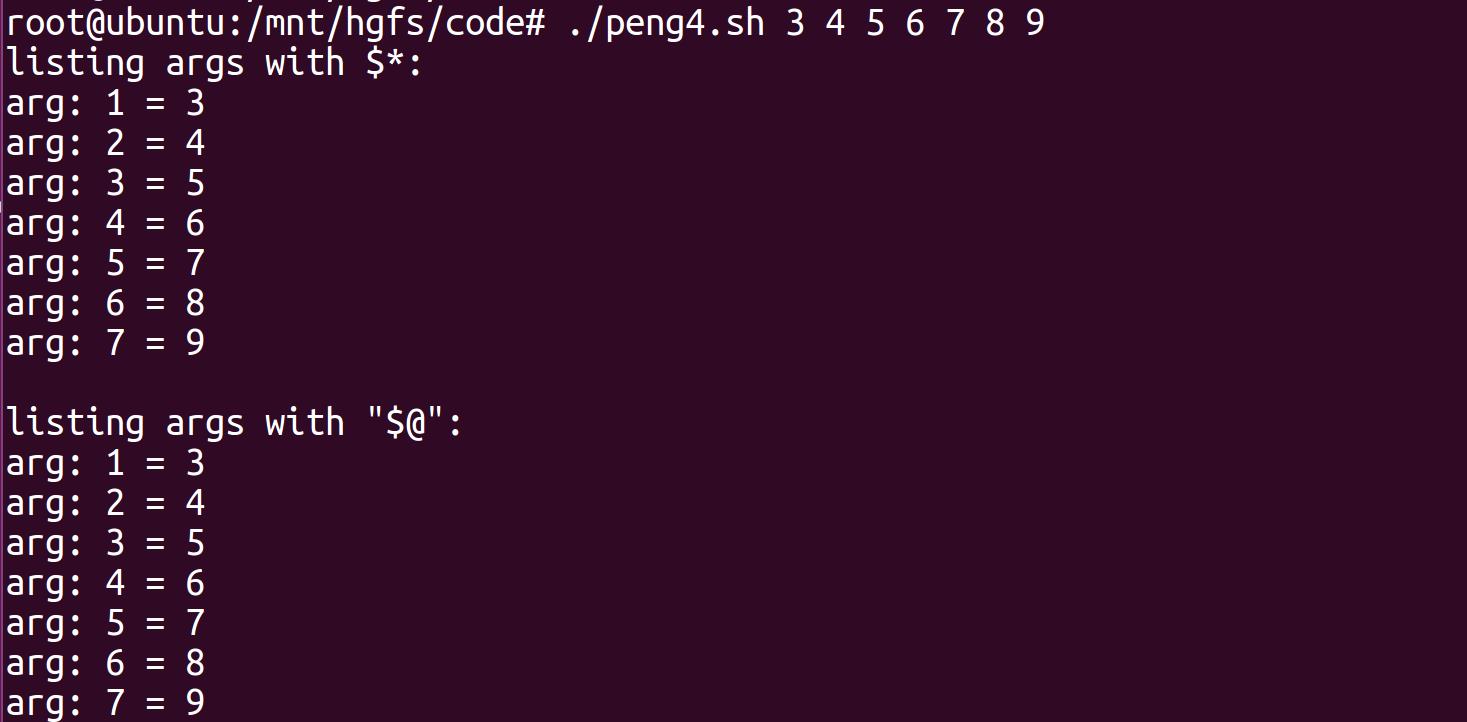shell脚本中$0 $1 $# $@ $* $? $$ 的各种符号意义详解
Posted 一口Linux
tags:
篇首语:本文由小常识网(cha138.com)小编为大家整理,主要介绍了shell脚本中$0 $1 $# $@ $* $? $$ 的各种符号意义详解相关的知识,希望对你有一定的参考价值。

一、概述
shell中有两类字符:普通字符、元字符。
1. 普通字符
在Shell中除了本身的字面意思外没有其他特殊意义,即普通纯文本;
2. 元字符
是Shell的保留字符,在Shell中有着特殊的含义。


今天主要介绍一下shell中字符$的各种用法。
二、转义字符$
在linux shell脚本中经常用到字符$,下面是$的一些常见用法
| 名称 | 含义 |
|---|---|
| $# | 传给脚本的参数个数 |
| $0 | 脚本本身的名字 |
| $1 | 传递给该shell脚本的第一个参数 |
| $2 | 传递给该shell脚本的第二个参数 |
| $@ | 传给脚本的所有参数的列表 |
| $* | 以一个单字符串显示所有向脚本传递的参数,与位置变量不同,参数可超过9个 |
| $$ | 脚本运行的当前进程ID号 |
| $? | 显示最后命令的退出状态,0表示没有错误,其他表示有错误 |
实例1
建立脚本peng.sh如下:
#/bin/bash
total=$[ $1 * $2 + $3 ]
echo "$1 * $2 + $3 = $total"
运行如下:
./peng.sh 4 5 6
结果如下:

实例2
当把字符串输入给shell脚本的时候,注意是以空格作为分隔符,如果字符串本身就有空格的话,那么用双引号或者单引号,比如
#/bin/bash
echo "$1 is pretty nice!"
运行如下:
./peng.sh 一口Linux
结果如下:

实例3
#!/bin/sh
echo "参数个数:$#"
echo "脚本名字:$0"
echo "参数1:$1"
echo "参数2:$2"
echo "所有参数列表:$@"
echo "pid:$$"
if [ $1 = 100 ]
then
echo "命令退出状态:$?"
exit 0 #参数正确,退出状态为0
else
echo "命令退出状态:$?"
exit 1 #参数错误,退出状态1
fi
执行结果:

实例4
使用for循环进行参数遍历
示例:
#!/bin/bash
number=65 #定义一个退出值
index=1 #定义一个计数器
if [ -z "$1" ];then #对用户输入的参数做判断,如果未输入参数则返回脚本的用法并退出,退出值65
echo "Usage:$0 + 参数"
exit $number
fi
echo "listing args with \\$*:" #在屏幕输入,在$*中遍历参数
for arg in $*
do
echo "arg: $index = $arg"
let index+=1
done
echo
index=1 #将计数器重新设置为1
echo "listing args with \\"\\$@\\":" #在"$@"中遍历参数
for arg in "$@"
do
echo "arg: $index = $arg"
let index+=1
done


实例5
小技巧1:在" ∗ " 和 *"和 ∗"和*中遍历参数的区别
示例:
#!/bin/bash
number=11
if [ $# -eq 0 ];then
echo "Usage: $0 + 参数"
exit $number
fi
for i in $* #在$*中遍历参数,此时每个参数都是独立的,会遍历$#次
do
echo $i
done
echo
for i in "$*" #在"$*"中遍历参数,此时"$*"被扩展为包含所有位置参数的单个字符串,只遍历一次
do
echo $i
done

三、linux命令执行返回值**$?**说明
在 Linux 下,不管你是启动一个桌面程序也好,还是在控制台下运行命令,所有的程序在结束时,都会返回一个数字值,这个值叫做返回值,或者称为错误号 ( Error Number )。
1. 在控制台下,有一个特殊的环境变量 $?,保存着前一个程序的返回值,我们可以试试:

先随便执行个命令,比如像上面的 ls 某些文件,然后通过 echo $?,打印 $? 的值~
我们发现返回值是 0,这是什么意思呢?
只要返回值是 0,就代表程序执行成功了~
也就是说,如果 $? 变量的值不是 0 的话,就表示上一个命令在执行的过程中出错了。
2. 我们可以试着 ls 一个不存在的文件:

这样,对于某些打印出一堆不熟悉的英文信息的命令,可以方便的看出它是否成功执行结束。
不过,每次都 echo $? 一下太累了,没关系,你可以把 $? 放在提示符里去:
3. 将上次命令执行是否成功的返回值放到提示符里面去:export PS1="[\\$?]${PS1}"
root@ubuntu:/home/peng/zhh# export PS1="[\\$?]${PS1}"
[0]root@ubuntu:/home/peng/zhh# ls

export PS1="[\\$?]${PS1}" 这个命令把 $? 的值放在的提示符的最前面,这样每次执行完命令,这个值都会自动更新,这下就一目了然了~
4. 用perror查看错误提示
那么如果返回的值不是 0,我们要怎么知道是那里出错了呢?
大多数的程序出错都会给出提示,如果没有提示的话,可以用 perror 这个程序来查看错误的信息,比如返回值是 2,我们可以运行下面命令:
$ perror 2
OS error code 2: No such file or directory
这样就清楚了,原来是文件不存在~
该命令需要安装
apt-get install perror
5. 给出错误代码及其具体原因对照表:
"OS error code 1: Operation not permitted"
"OS error code 2: No such file or directory"
"OS error code 3: No such process"
"OS error code 4: Interrupted system call"
"OS error code 5: Input/output error"
"OS error code 6: No such device or address"
"OS error code 7: Argument list too long"
"OS error code 8: Exec format error"
"OS error code 9: Bad file descriptor"
"OS error code 10: No child processes"
"OS error code 11: Resource temporarily unavailable"
"OS error code 12: Cannot allocate memory"
"OS error code 13: Permission denied"
"OS error code 14: Bad address"
"OS error code 15: Block device required"
"OS error code 16: Device or resource busy"
"OS error code 17: File exists"
"OS error code 18: Invalid cross-device link"
"OS error code 19: No such device"
"OS error code 20: Not a directory"
"OS error code 21: Is a directory"
"OS error code 22: Invalid argument"
"OS error code 23: Too many open files in system"
"OS error code 24: Too many open files"
"OS error code 25: Inappropriate ioctl for device"
"OS error code 26: Text file busy"
"OS error code 27: File too large"
"OS error code 28: No space left on device"
"OS error code 29: Illegal seek"
"OS error code 30: Read-only file system"
"OS error code 31: Too many links"
"OS error code 32: Broken pipe"
"OS error code 33: Numerical argument out of domain"
"OS error code 34: Numerical result out of range"
"OS error code 35: Resource deadlock avoided"
"OS error code 36: File name too long"
"OS error code 37: No locks available"
"OS error code 38: Function not implemented"
"OS error code 39: Directory not empty"
"OS error code 40: Too many levels of symbolic links"
"OS error code 42: No message of desired type"
"OS error code 43: Identifier removed"
"OS error code 44: Channel number out of range"
"OS error code 45: Level 2 not synchronized"
"OS error code 46: Level 3 halted"
"OS error code 47: Level 3 reset"
"OS error code 48: Link number out of range"
"OS error code 49: Protocol driver not attached"
"OS error code 50: No CSI structure available"
"OS error code 51: Level 2 halted"
"OS error code 52: Invalid exchange"
"OS error code 53: Invalid request descriptor"
"OS error code 54: Exchange full"
"OS error code 55: No anode"
"OS error code 56: Invalid request code"
"OS error code 57: Invalid slot"
"OS error code 59: Bad font file format"
"OS error code 60: Device not a stream"
"OS error code 61: No data available"
"OS error code 62: Timer expired"
"OS error code 63: Out of streams resources"
"OS error code 64: Machine is not on the network"
"OS error code 65: Package not installed"
"OS error code 66: Object is remote"
"OS error code 67: Link has been severed"
"OS error code 68: Advertise error"
"OS error code 69: Srmount error"
"OS error code 70: Communication error on send"
"OS error code 71: Protocol error"
"OS error code 72: Multihop attempted"
"OS error code 73: RFS specific error"
"OS error code 74: Bad message"
"OS error code 75: Value too large for defined data type"
"OS error code 76: Name not unique on network"
"OS error code 77: File descriptor in bad state"
"OS error code 78: Remote address changed"
"OS error code 79: Can not access a needed shared library"
"OS error code 80: Accessing a corrupted shared library"
"OS error code 81: .lib section in a.out corrupted"
"OS error code 82: Attempting to link in too many shared libraries"
"OS error code 83: Cannot exec a shared library directly"
"OS error code 84: Invalid or incomplete multibyte or wide character"
"OS error code 85: Interrupted system call should be restarted"
"OS error code 86: Streams pipe error"
"OS error code 87: Too many users"
"OS error code 88: Socket operation on non-socket"
"OS error code 89: Destination address required"
"OS error code 90: Message too long"
"OS error code 91: Protocol wrong type for socket"
"OS error code 92: Protocol not available"
"OS error code 93: Protocol not supported"
"OS error code 94: Socket type not supported"
"OS error code 95: Operation not supported"
"OS error code 96: Protocol family not supported"
"OS error code 97: Address family not supported by protocol"
"OS error code 98: Address already in use"
"OS error code 99: Cannot assign requested address"
"OS error code 100: Network is down"
"OS error code 101: Network is unreachable"
"OS error code 102: Network dropped connection on reset"
"OS error code 103: Software caused connection abort"
"OS error code 104: Connection reset by peer"
"OS error code 105: No buffer space available"
"OS error code 106: Transport endpoint is already connected"
"OS error code 107: Transport endpoint is not connected"
"OS error code 108: Cannot send after transport endpoint shutdown"
"OS error code 109: Too many references: cannot splice"
"OS error code 110: Connection timed out"
"OS error code 111: Connection refused"
"OS error code 112: Host is down"
"OS error code 113: No route to host"
"OS error code 114: Operation already in progress"
"OS error code 115: Operation now in progress"
"OS error code 116: Stale NFS file handle"
"OS error code 117: Structure needs cleaning"
"OS error code 118: Not a XENIX named type file"
"OS error code 119: No XENIX semaphores available"
"OS error code 120: Is a named type file"
"OS error code 121: Remote I/O error"
"OS error code 122: Disk quota exceeded"
"OS error code 123: No medium found"
"OS error code 124: Wrong medium type"
"OS error code 125: Operation canceled"
"OS error code 126: Required key not available"
"OS error code 127: Key has expired"
"OS error code 128: Key has been revoked"
"OS error code 129: Key was rejected by service"
"OS error code 130: Owner died"
"OS error code 131: State not recoverable"
"mysql error code 132: Old database file"
"MySQL error code 133: No record read before update"
"MySQL error code 134: Record was already deleted (or record file crashed)"
"MySQL error code 135: No more room in record file"
"MySQL error code 136: No more room in index file"
"MySQL error code 137: No more records (read after end of file)"
"MySQL error code 138: Unsupported extension used for table"
"MySQL error code 139: Too big row"
"MySQL error code 140: Wrong create options"
"MySQL error code 141: Duplicate unique key or constraint on write or update"
"MySQL error code 142: Unknown character set used"
"MySQL error code 143: Conflicting table definitions in sub-tables of MERGE table"
"MySQL error code 144: Table is crashed and last repair failed"
"MySQL error code 145: Table was marked as crashed and should be repaired"
"MySQL error code 146: Lock timed out; Retry transaction"
"MySQL error code 147: Lock table is full; Restart program with a larger locktable"
"MySQL error code 148: Updates are not allowed under a read only transactions"
"MySQL error code 149: Lock deadlock; Retry transaction"
"MySQL error code 150: Foreign key constraint is incorrectly formed"
"MySQL error code 151: Cannot add a child row"
"MySQL error code 152: Cannot delete a parent row"
以上是关于shell脚本中$0 $1 $# $@ $* $? $$ 的各种符号意义详解的主要内容,如果未能解决你的问题,请参考以下文章